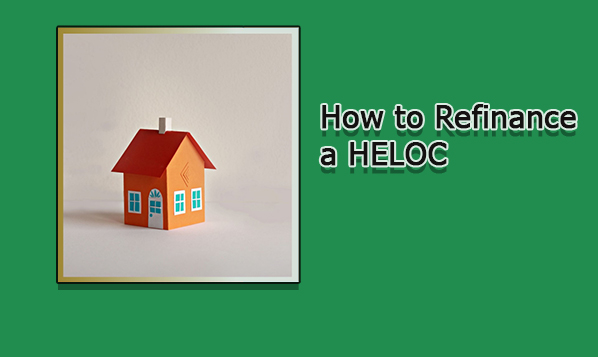You have been paying back the interest on your withdrawals from a home equity line of credit (HELOC) that you took out a few years ago. You have to start paying off your principal balance with interest now that the draw period is coming to an end. However, these bigger payments are a true hardship. The best solution is to refinance an HELOC.

By lowering your interest rate, your payment amount, or both, you can refinance your HELOC, which lowers your monthly payments. Additionally, there are a number of ways you can refinance a HELOC. In this article, we will highlight several methods that are the best solution to refinance a HELOC.
How to Refinance a HELOC
A home equity line of credit (HELOC) is a financing option that allows borrowing against the value of your house with lenders approving a certain balance. Compared to unsecured loans, HELOC have lower interest rates because they are secured by your home. However, the lender may foreclose on your house if you don’t make your payments.
The following are methods to refinance a HELOC:
Open a new HELOC
You can improve your financial stability and avoid repayment for an additional ten years by refinancing your HELOC with a new 10-year draw period and interest-only repayment period. However, because HELOC interest rates fluctuate, there is a chance that interest payments will increase over time. Furthermore, borrowing becomes simpler when you enter a new draw period. However, taking on more debt may make your financial status more precarious. To guarantee a more stable financial future, it is crucial to thoroughly weigh the advantages and disadvantages before refinancing.
Refinance into a home equity loan
Home equity is used as collateral against the loan balance in a home equity loan. It can lessen the payment shock that HELOCs frequently cause. This is because it has a fixed interest rate, a fixed payment for the duration, and no draw period. However, there are closing costs and fees involved as well. To prevent the shock that occurs when payments become unaffordable, the borrower must make artificially low payments.
Loan modification
Requesting a change to your loan’s terms or interest rate to manage your monthly payments is known as loan modification. For people who are worried about payment issues following the draw and repayment periods, this option is advantageous. Longer repayment terms, possibly lower interest rates, and the ability to free up funds for other debts are among the advantages. It’s not always possible, though, and your request might be turned down.
Fixed-rate loan
Since most HELOCs have variable interest rates, it can be challenging to forecast your monthly payments. Borrowers may choose to refinance into a fixed-rate loan using a personal loan or a home equity loan. Generally, home equity and personal loans are paid directly to an existing loan or deposited as a single, lump sum into your bank account. You can convert to a fixed monthly payment plan and use that lump sum to pay off the remaining balance on your HELOC.
Refinance into a new mortgage
To lower total interest payments, think about refinancing into a 15- or 20-year mortgage. Primary mortgage interest rates are typically lower than HELOC interest rates. However, this approach typically requires a lot of paperwork and is more complex. Closing costs must also be taken into account. Therefore, it is usually best to take out a new mortgage that includes your HELOC only if you are able to obtain a much lower interest rate.
Refinance using a personal loan
In addition to providing advantages like exchanging debt linked to your home equity for new debt without putting your house at risk, a personal loan settles your HELOC. You won’t lose your house if you default on a personal loan, but it can harm your credit score and possibly result in a lawsuit. On the other hand, mortgage interest rates are usually lower, which could result in higher total interest or higher payments.
Get cash out refinance
By paying off your mortgage and HELOC with a single loan, cash out refinance can lower your monthly payments and possibly lock in a fixed interest rate. Depending on the value of your house, this option gives you extra money for a variety of purposes. However, there are closing costs and fees, longer terms, and a longer repayment period.
What If I Don’t Refinance HELOC
If you cannot refinance your Home Equity Line of Credit (HELOC), loan modification may be your only option. Especially if you are underwater on your mortgage, your credit score has reduced below 620, or your income is too low to make monthly payments. Before you miss a single payment, you must speak with your loan servicer and explain your circumstances in order to apply for a loan modification.
You might have to finish a three-month trial period to prove that you can make the changed payments if the lender doesn’t require modification. However, your credit score might decline if you choose this course of action. A loan modification might be a good option if you are unable to repay your loan.
Should I Refinance My HELOC
Before refinancing your HELOC, it is crucial to assess your initial reasons for considering such a move. The cost of borrowing from your HELOC may be reduced if you’re refinancing to reduce your interest rate.
However, you might wind up taking out a longer-term loan that is more expensive if you are refinancing because you are unable to make the monthly payments. Regardless of why you are refinancing, be sure you are aware of your objectives and the possible short- and long-term effects of the process.

